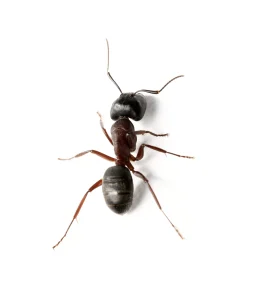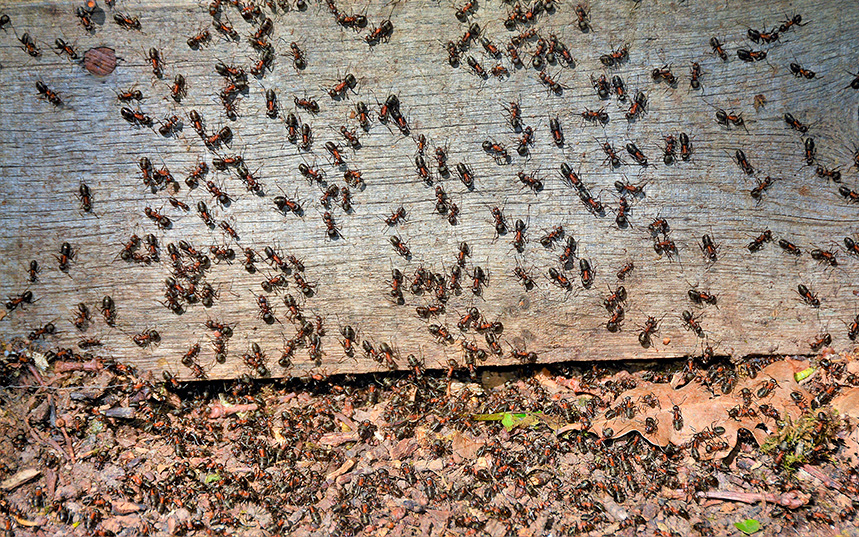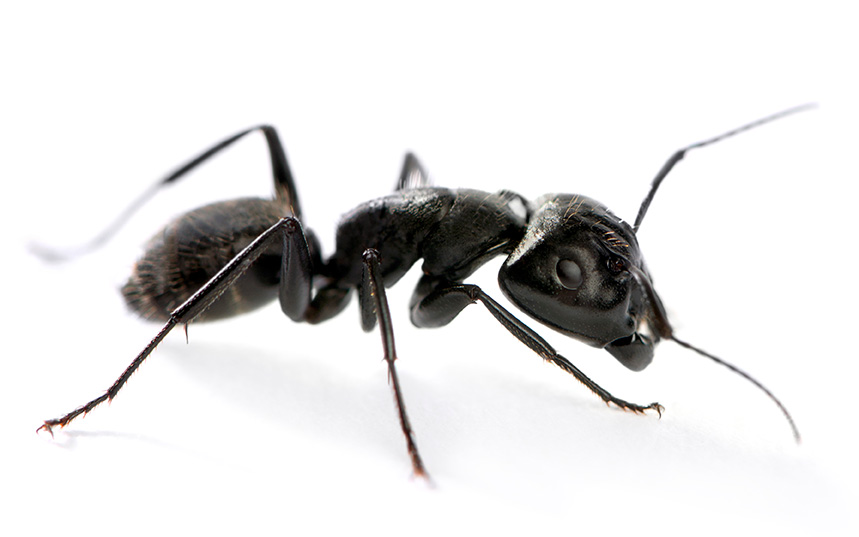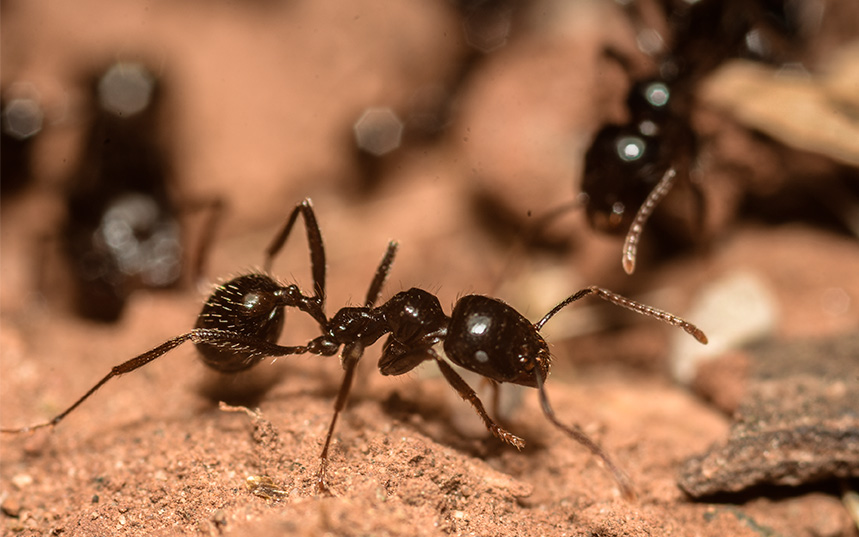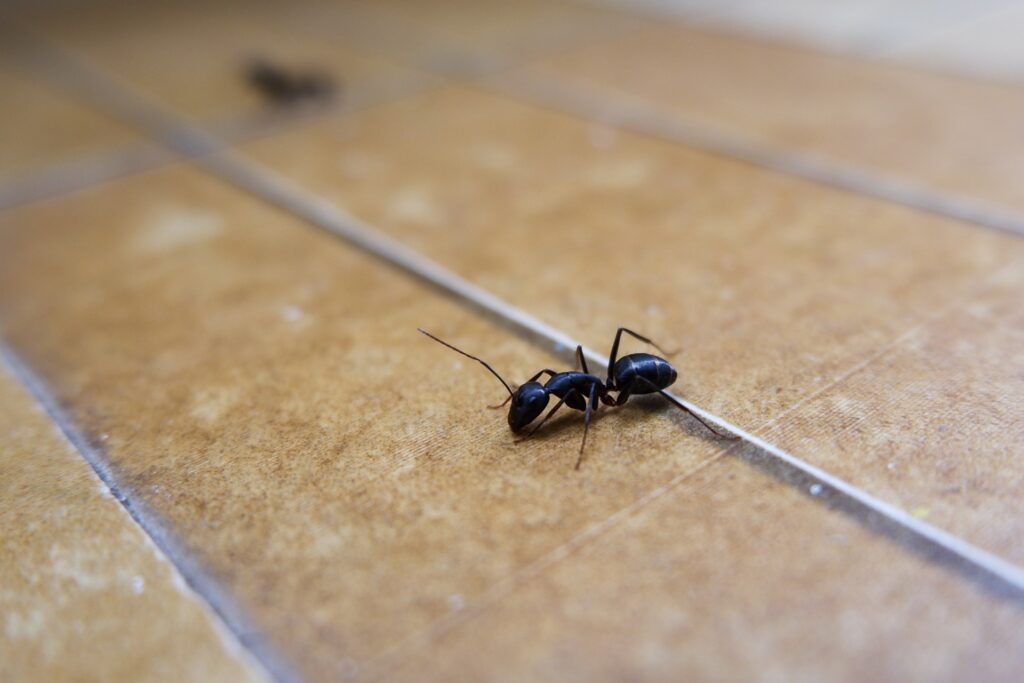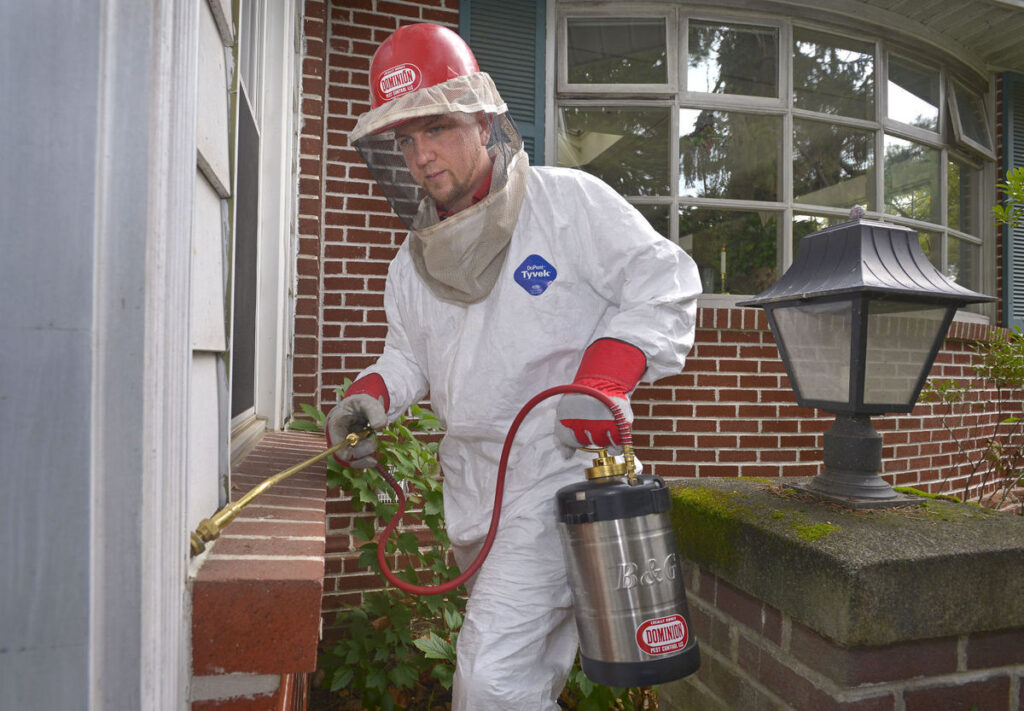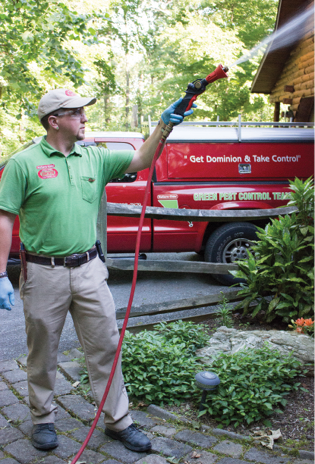How to Tell if You Have Ants
Wondering how to tell if you have ants? Look for long, visible lines along walls, countertops & baseboards, musty, rotten coconut smell, presence of piles of sawdust or wood shavings, appearance of winged swarmers indoors, a faint chewing sound in walls, or dirt mounds, which can all indicate ant activity.
A Dominion Pest Control technician can conduct a thorough ant inspection and can identify an ant infestation. If you have a ant problem in your home or business, we will create an ant treatment plan that results in efficient, effective ant extermination. We are experts on how to kill ants and our treatment will kill any ant colony on your property.
Ants
What Are the Most Common Types of Ants in Pennsylvania?
Ants come in different shapes, sizes, and behaviors. Understanding the specific type of ants invading your home can help you develop a more targeted ant pest control approach. Below are the most common ant species in Pennsylvania.
ODOROUS ANTS
In Central Pennsylvania, the most common type of ant is the odorous house ant. These ants get their name from the coconut smell they omit when crushed. Because these tiny ants measure only 1/16 to 1/8 inch long, local residents refer to them as “small ants.” Since they are often found near juice or sugary crumbs inside the home, they are also known as sugar ants.
Odorous house ants, particularly flying ants, are usually very difficult for the average homeowner to get rid of. The reason for this is an instinct called “fracturing” – or “budding,” as ant control companies call it. In a major ant infestation, When a certain number of ants do not return to the colony due to over-the-counter sprays, the colony will panic and split. This means double the trouble! New customers who call Dominion Pest Control often describe this situation, saying “The more we spray, the worse they get!”
Unlike many other pest control companies, Dominion uses highly effective ant pest control strategies that kill entire ant colonies of ants – no matter the species. Ant prevention is one of our specialties.
Download our Odorous House Ants Treatment Prep Sheet.
CARPENTER ANTS
Another common type of ant in Pennsylvania is the carpenter ant. Carpenter ants are true to their name: They actually bore the wood in your home or business. A piece of moist excavated wood and a pile of sawdust are telltale signs of these pests. If left unchecked, these ants will do almost as much damage as termites.
Because of their appearance, carpenter ants are also known as “big black ants.” They measure between 3/8 and 1/2 inches long and have segmented bodies and prominent mandibles. These insects thrive on water and usually set up shop near leaking air conditioners, bird baths, and other water sources. If you want to know how to get rid of big black ants, click here to learn more about carpenter ants.
PAVEMENT ANTS
Pavement ants are another species commonly found in Pennsylvania. These pests can be seen pushing up dirt in the yard and the sides of driveway. You may also see them crawling on the kitchen counter.
Ranging from 1/16 of an inch to 1/8 of an inch long, pavement ants appear wrinkled and are brown to dark brown.
By identifying the type of ant you’re dealing with, you can tailor your ant control efforts accordingly.
ASIAN NEEDLE ANTS
Asian needle ants are an invasive, stinging species increasingly found in shaded, mulched, or wooded areas across Pennsylvania, including Lancaster and York counties. Known for their painful stings and ecological impact, these ants can pose a serious risk to both humans and pets. Unlike common ant species, they often nest in damp debris and may enter homes during hot or dry weather.
Read our full guide to Asian needle ants to learn how to identify them, reduce nesting conditions, and get expert help from Dominion Pest Control.
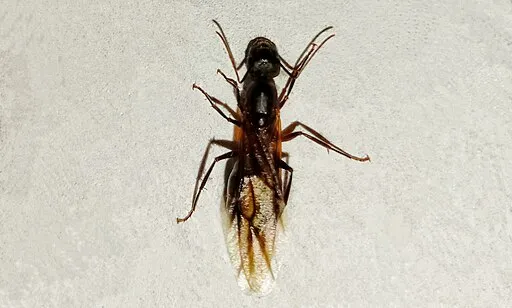
Flying Ants vs. Termites
Before you act, it’s also good to know what insect you’re dealing with. Flying ants, or winged ants, as they’re often called, include all the types above. When in flight, they’re often hard to distinguish – so it’s best to have a Dominion Pest Control technician inspect whether you have swarming termites or flying ants.
While both insects have four wings, the wings of termites are equal in length and twice as long as their bodies. They also have straight antenna and a straight body. Flying ants, on the other hand, have noticeably larger wings in the front and bent antennas. Because of their thin abdomens, they also appear distinctly segmented. If you’re interested in how to get rid of flying ants, it helps if you can identify them on sight.
When are Ants Most Active in Pennsylvania?
Ant activity is influenced by temperature, food availability, and colony growth cycles. In Pennsylvania, ants are most active in the spring and summer when warmer temperatures encourage foraging and colony expansion. However, some species, like carpenter ants, can remain active indoors year-round, especially if they have access to warmth and moisture. Check out this video of ants rebuilding a shelter tube into a local home.
Pennsylvania has diverse environments, from rural forests and farmland to suburban neighborhoods and urban centers, all of which influence ant populations differently.
Eastern Pennsylvania (Philadelphia, Allentown, Reading) – Higher urbanization leads to increased indoor infestations of nuisance ants, particularly odorous house ants and pavement ants. Milder winters due to urban heat can allow these ants to remain active indoors year-round. Construction and landscaping changes often disrupt soil, encouraging pavement ant nesting around sidewalks, driveways, and building foundations.
Central Pennsylvania (Harrisburg, Lancaster, State College) – Carpenter ants thrive in wooded areas, especially near homes with damp or untreated wood. Suburban and rural areas may also experience pavement ant activity, particularly around homes with concrete patios or driveways. Odorous house ants can invade homes, especially in the spring when searching for moisture and food sources.
Western Pennsylvania (Pittsburgh, Erie, Johnstown) – Colder winters slow outdoor ant activity, but carpenter ants can still be a problem in older wooden structures or homes with moisture issues. Indoor infestations of odorous house ants may persist, as they seek warmth and food inside homes. Pavement ants are commonly found nesting in concrete cracks and along building foundations.
Northern Pennsylvania (Scranton, Williamsport, Pocono Mountains) – With *dense forests and higher elevations, carpenter ants are a major concern, particularly in homes near wooded areas. The shorter warm season leads to peak ant activity in late spring and summer. Pavement ant infestations are less common due to the lower level of urbanization compared to southern Pennsylvania.
Southern Pennsylvania (York, Gettysburg, Chambersburg) – A milder climate allows ants to remain active later into the fall compared to northern PA. Odorous house ants frequently invade homes, especially during wet spring months. Pavement ants are a common issue in suburban areas, where they nest around sidewalks, patios, and driveways. Carpenter ants can also be found in wooded sections of this region, particularly near homes with untreated wood or moisture problems.
Signs of an Ant Infestation
One of the most noticeable signs of an ant infestation is the presence of trails. Odorous house ants and pavement ants travel in long, visible lines along walls, countertops, and baseboards, especially in kitchens and pantries. These trails are formed as worker ants leave a pheromone scent to guide others to food sources. Odorous house ants have a strong preference for sweet foods, while pavement ants are attracted to both sugary and greasy substances. They are sometimes called “sugar ants” because of this.
Also, odorous house ants emit a musty, rotten coconut smell when crushed. If ants are frequently spotted indoors and emit an unusual odor when killed, they are likely odorous house ants. This scent is a key identifier and can sometimes be noticed in areas where large colonies are nesting, This species is particularly persistent and will relocate its colony if disturbed, making them difficult to eliminate without professional pest control services.
A clear indicator of carpenter ant activity is the presence of piles of sawdust or wood shavings, often called frass. Unlike termites, carpenter ants do not eat wood but excavate it to create tunnels for nesting. These small piles of fine, powdery material may appear near wooden structures, baseboards, window frames, or cabinets. If frass is found inside the home, it’s a strong sign that carpenter ants have already established a nest within the structure.
Another red flag is the appearance of winged swarmers indoors, particularly in the spring. Carpenter ants produce reproductive swarmers, which fly out to establish new colonies. Seeing a few swarmers inside may not be cause for concern, but if they appear repeatedly or in large numbers, it likely indicates an active carpenter ant nest within the home. Discarded wings near windows, doors, or light fixtures can further confirm their presence.
Carpenter ants can sometimes be heard before they are seen. Homeowners may notice a faint rustling or chewing noise coming from inside walls, wooden beams, or floors. These sounds are produced as the ants tunnel through wood and expand their nests.
For pavement ants, small dirt mounds appearing in cracks of sidewalks, driveways, patios, or along foundations can be a telltale sign. These ants create underground nests and push soil upward as they dig, forming small piles of loose dirt. While their nests are often located outdoors, pavement ants frequently enter homes, especially through basement walls and foundation cracks, in search of food and moisture.
Finally, the presence of ants in moist or water-damaged areas can indicate an infestation.
Recognizing these signs early is key to preventing a minor ant problem from turning into a full-blown infestation. Whether it’s trails of foraging ants, piles of frass, winged swarmers, or odd smells, each sign provides a clue to the type of ant involved and the extent of the infestation. If any of these indicators are present, it’s important to act. Contact one of our pest control experts to quickly properly identify, seal entry points, and apply effective control methods to prevent further spread.
How to Get Rid of Ants in the House (Quickly and Permanently)
If you’ve ever had the frustrating experience of ants invading your home, you know how important it is to get rid of them quickly and permanently. No one wants those little critters crawling all over their kitchen countertops or pantry. But how can you eliminate an ant infestation? If you’re wondering how to get rid of ants once and for all, read on!
Once you know the type of ants in your house, it’s time to develop a targeted plan to eliminate them. Dominion Pest Control may use the following ant treatment options:
- Baits – Store bought baits are a common DIY method for killing ants. It is important to keep in mind that the treatment method depends on the ant species. For example, odorous house ants are attracted to sweet baits while carpenter ants are drawn to protein-based baits.
- Insecticides – If your ant problem is confined to a small area, you can spot-treat it with an insecticide. Liquid insecticides or granules can help you to get rid of ants in specific locations, but for larger scale infestations, you may need a lawn insect killer that contains bifenthrin. Be sure to mow the grass before applying insecticides outdoors; doing so reduces the real estate on which these pests can reside.
We recommend you call Dominion before using insecticide. When using any type of insecticide, it’s imperative to read the product label carefully to ensure proper handling and application techniques. You should also wear protective gear and thoroughly clean up any residual material. Incorrect use can be ineffective, hazardous to your health, and may even worsen the infestation by causing ants to scatter and form new colonies. - Natural Ant Treatments– If you prefer to take a more natural approach to ant control, there are several remedies you can try. One popular method is using a 50/50 mixture of vinegar and water. Spray this solution near ant trails, entry points, and areas where ants frequent. The strong smell of vinegar disrupts their scent trails and deters them from returning.
Another natural option is using cinnamon. Sprinkle cinnamon powder along ant trails or near entry points to create a barrier that ants dislike crossing.
Additionally, essential oils such as peppermint, citrus, or tea tree oil can be effective in repelling ants. Dilute a few drops of the oil in water and spray it around problem areas.
Remember that while DIY methods may help you to get rid of ants quickly, they don’t eliminate them permanently. At Dominion Pest Control, we use professional grade Nature-Cide All Purpose Concentrate to get rid of ants in your house quickly and permanently. This commercial blend kills not only ants, but also bed bugs, cockroaches, fleas, mosquitoes, ticks, and other insects on contact. This powerful solution is formulated with clove oil, cottonseed oil, and other natural ingredients, so you won’t have to worry about health risks to your family or pets.
Our pest control experts know exactly what type of insecticide to apply and where to apply it. Learn more about the Dangers of Self Treating for Pests.
Common Options We Do Not Recommend
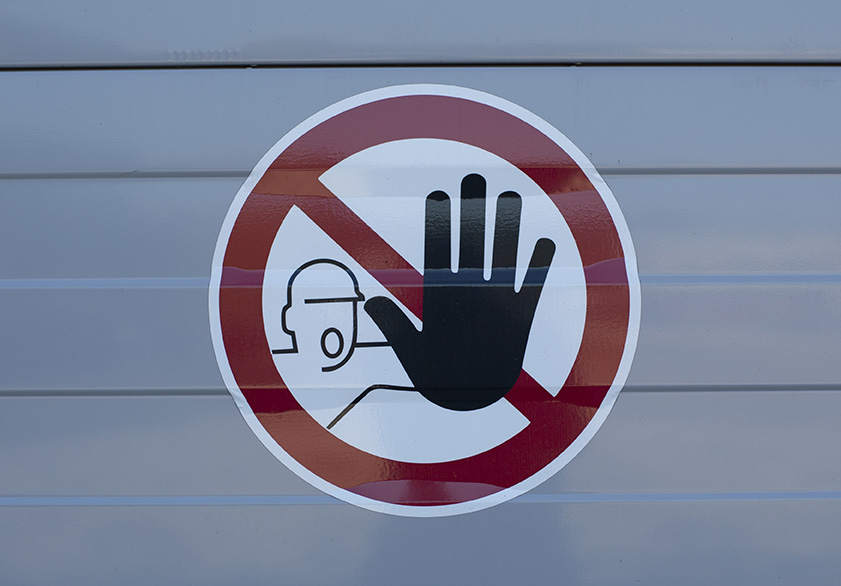
- Pouring Boiling Water or Chemicals into Ant Nests – This is often attempted for pavement ants, but it rarely works. Pouring boiling water or chemicals into an ant nest may kill some ants near the surface, but it does not reach the deeper colony. Additionally, carpenter ants and odorous house ants often nest inside walls or other hidden areas, where this method would be completely ineffective.
- Blocking Carpenter Ant Exit Holes Without Treating the Nest – Carpenter ants often create visible exit holes in wooden structures where they push out sawdust-like frass. Some homeowners attempt to seal these holes, thinking it will trap the ants inside. However, this can force them to create new exit points deeper inside the structure, leading to more hidden damage over time.
- Spraying Vinegar as a Primary Solution – Vinegar may disrupt ant trails temporarily but do not eliminate the colony. In fact, disrupting trails can cause ants to scatter and establish new paths, making it harder to locate and bait them properly
What’s My Next Step for Ant Control?
Choose peace of mind! If you suspect you have an ant infestation, use our form to start living pest-free. Dominion Pest Control will get in touch ASAP.
- Pricing: Most professional ant extermination programs cost $150-$500. After our professional exterminator conducts an official inspection, they can provide a quote for ant removal. The final cost can vary significantly based on multiple factors, making an inspection and quote the best first step.
How to Prepare for Your Exterminator: Essential Tips for a Successful Treatment
Preparation for your ant extermination will depend on which treatment option is needed to control the pests in your home or building. Your technician can go over any preparation needs.
Prevention: Best Next Steps to Avoid Re-Infestation of Ants
Getting rid of ants is important but preventing them from returning should be the ultimate goal. To keep these pesky critters at bay, here are a few basic preventive measures you can take:
- Cleanliness: Keep things clean by regularly wiping down surfaces, sweeping up crumbs, and storing food in airtight containers. Ants are attracted to even the tiniest food traces, so a clean environment is a deterrent. Don’t let unwashed dishes with food debris pile up in your sink, that’s an inviting banquet for any ants that may enter via gaps around your pipes and plumbing. Immediately clear away any leftover food scraps and seal them in closed trash bags and lidded containers for disposal. Take extra special care to police the area around your trash bins for signs of invading ants.
- Block access: Once ants are detected, conduct a thorough inspection of your home. Secure potential entryways by sealing cracks or gaps in windows, doors, and foundation walls.
- Introduce deterrents: Consider applying ant deterrents like diatomaceous earth, mint leaves, or lemon juice near access points to discourage ants from entering your home. This will be a temporary deterrent.
- Read: Odorous House Ants resource sheet.
By paying attention to the causes of ant infestation and following these preventative measures, you can maintain an ant-free environment in your house.
FAQs
Will ants eat margarine or butter?
Yes, ants may eat butter or margarine if they are seeking fats or oils. Pavement ants, in particular, are known to forage for greasy or oily foods, and carpenter ants will also consume fats when available.
Why are ants in my bathroom?
Odorous house ants and carpenter ants are highly attracted to moisture. Bathrooms often provide leaky pipes, damp wood, or condensation, which can draw ants in, even if no food is present. Carpenter ants, in particular, prefer to nest in damp wood, making bathrooms and basements prime real estate for their colonies.
Can ants swim?
While ants can’t truly swim like aquatic creatures, they are remarkably resilient in water. Some ants can survive underwater for hours or even days by entering a low-energy state and sealing off their spiracles (breathing holes). If you see ants in water and think they’ve drowned, some may still recover once they dry out!
Why do ants suddenly disappear and then come back?
Ant colonies adjust their foraging behavior based on weather, food availability, and colony needs. Odorous house ants and pavement ants may seem to vanish when they find an abundant food source elsewhere but can return days or weeks later. Carpenter ants, especially, may seem to disappear if they move deeper into a structure to expand their nest
Can carpenter ants chew through plastic?
Not exactly. Carpenter ants don’t eat wood, but they chew through materials to make tunnels. They can gnaw through foam insulation, soft plastics, and even electrical wiring if it’s their way. This makes them a serious concern in homes, as their activity can lead to hidden structural damage or even electrical shorts
